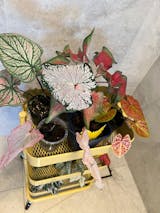Light: Houseplant Care Guide
Beginner's guide to light
One of the most important ingredients for a plant is light - ideally from the sun. It makes plants grow, keeps them healthy, and helps them to look lush. A happy plant is one that receives sunlight every day.
If you've ever looked at a plant care label, you've probably noticed a bunch of instructions, symbols and terms indicating whether a plant needs direct or indirect light, how bright that light should be, and more. In this section of the Houseplant Care Guide, we’ll explain what a few of these terms mean and how they apply to houseplants and your home.
Throughout each section of this guide we'll provide quick tips and summaries for those who want just the highlights. Followed by more information for those keen to dive in a bit deeper.

Quick tips about light
- Direct light is when the rays of the sun hit a plant directly. Indirect light (otherwise known as filtered light) is when it's filtered or bounced on to the plant
- Indirect light - areas of your home where sunlight (otherwise known as natural light) reaches will receive mostly indirect light
- Direct light - some areas may receive direct sunlight for certain hours of the day within an area of up to 30cm - usually very close to a window
- The majority of plants sold as indoor plants prefer indirect light
- Light meters are a great way to understand the brightness of any spot in your home
- The closer a plant is to a light source/window, the brighter the light it will receive is

So what type of light do houseplants like?
When it comes to houseplants, the reason they are so well adapted to living in our homes is because most come from rainforest-type areas where they live on the ground, sheltered under canopies or wrapped around trees
Essentially they live their whole lives in filtered sunlight or shade – the rays of the sun may not actually directly touch their leaves, but instead is bounced off their surroundings. Which brings us to the important step of defining light!
Direct vs indirect lightThe main distinction between direct and indirect light is whether the sun’s rays hit the plant or not. If they do, this is called direct light – think sunflowers growing in the middle of a meadow where the sun bears down on them all day. They receive direct light.

Here you can see nothing is obstructing the sun overhead from reaching those rows of sunflowers, therefore is direct light
Now for indirect light, think of the rainforest example described earlier – imagine a little plant at the trunk of a much larger one with a full canopy overhead, where it receives light that is bounced off leaves and trees. This is considered indirect/filtered light.

See in this image how it's lit up with natural light, but you can't see any sun rays lighting up the area? That's because light has bounced off other objects to illuminate this area
What about inside my home? How do I know which light is direct or indirect?Of course our homes are more than a little different to a rainforest - they are actually more like dark caves if anything, with a few tactically placed windows that allow beams of light into the home. Speaking broadly, the vast majority of natural light that the interior of a house receives is indirect light (and otherwise artificial light by way of lightbulbs). There are loads of factors that impact how naturally bright your home is including:
- The structure of your home
- The surrounding buildings and structures (including poles, trees etc.)
- Your windows - the size and positioning of them, any curtains or other coverings
- The aspect of your home (i.e. what direction it faces) as this will dictate how much light you receive at particular times of the day as the sun moves across the sky
Simply put, if you can see the sun’s rays hitting a spot, that’s direct light. Most commonly this will happen right up against a window, but many homes will not receive any direct light at all (due to the aforementioned factors). However your balcony, verandah or backyard may have one or many spots that receive direct light, so if there’s a direct light loving plant you’re after, then a spot outside may be just perfect for it!
Bright vs medium vs low light - what do these mean?These terms – bright, medium, low - get mentioned a lot. They’re on plant care labels, on blogs, in plant books and more. The brightness of light that a plant receives has a significant impact on its growth and health. Most people who appear to be amazing greenthumbs most likely have floor to ceiling windows, so their plants receive bright indirect light for much of the day! The position of your houseplant in your home can have a big impact on its growth and health – even the difference of a few metres has a huge impact on the level of brightness of a particular spot. But figuring it out is tricky as our human eyes are not made for reading light levels.
Our top tip for understanding light is to use a light meter. You can buy yourself a gadget that reads this, or keep it simple and download an app on your smartphone such as Plant Light (on iOS) which will read the light of a certain spot and tell you if it’s bright, medium or low light, removing the guesswork entirely.
As some background, lux and footcandles are both terms that used to describe the measurement of light, but for the sake of simplicity we’re not going to get into a bunch of detail here. The quick explanation - just like we measure distance in units such as kilometres or miles, for example, the brightness of light can be measured in units such as lux and footcandles.
If you're feeling sciencey, here's the definitions but if that's not your thing, keep reading and we'll give you some simple guidelines.
Light strength definitions:
Low – 500 – 2,500 lux
Medium - 2500 – 10,000 lux
Bright – 10,000 to 20,000 lux
Like we said earlier, there's loads of factors that impact how bright light is in a certain space, so these are rough guidelines only:
- Bright light - Placement is right next to a large window
- Medium light - Placement within 30cm to 2m from a window or other source of light
- Low light - Placement within 2 to 4m from a window
- No light - anything further than 4m from a window is likely to be considered "no light" as far as a plant is concerned
Understanding what areas of your home are suitable for plants that need "bright" light, as an example, will really help you figure out what are the right plants for your home. And the more realistic you can be about the light you can provide, the better off your plants will be.
Any questions?Can't figure out the best spot for your plant? Get in touch at hello@uprooted.com.au and we would be more than happy to give you some guidance!
Want to learn more?Head to our next section, which is all about watering your houseplant.








